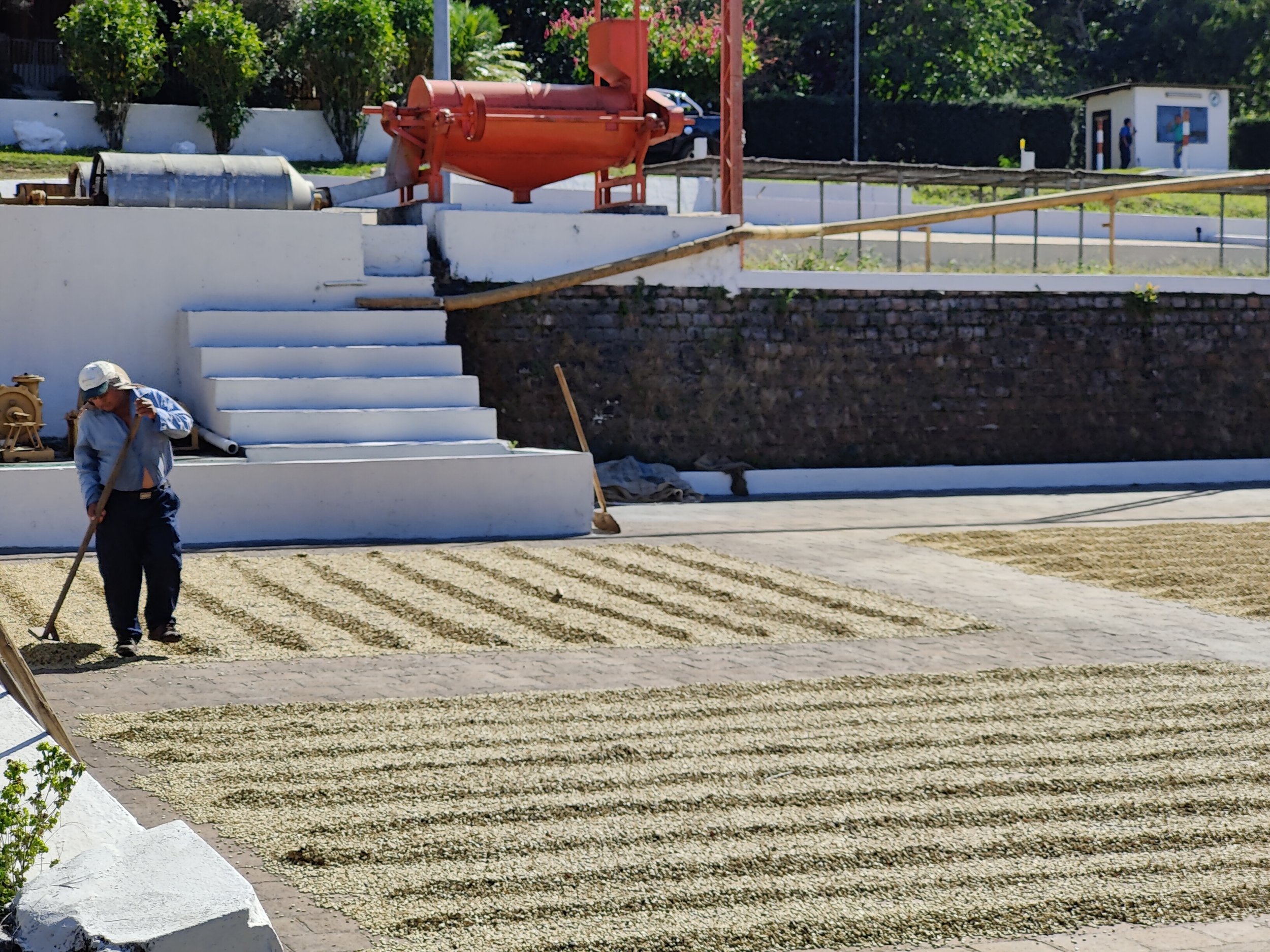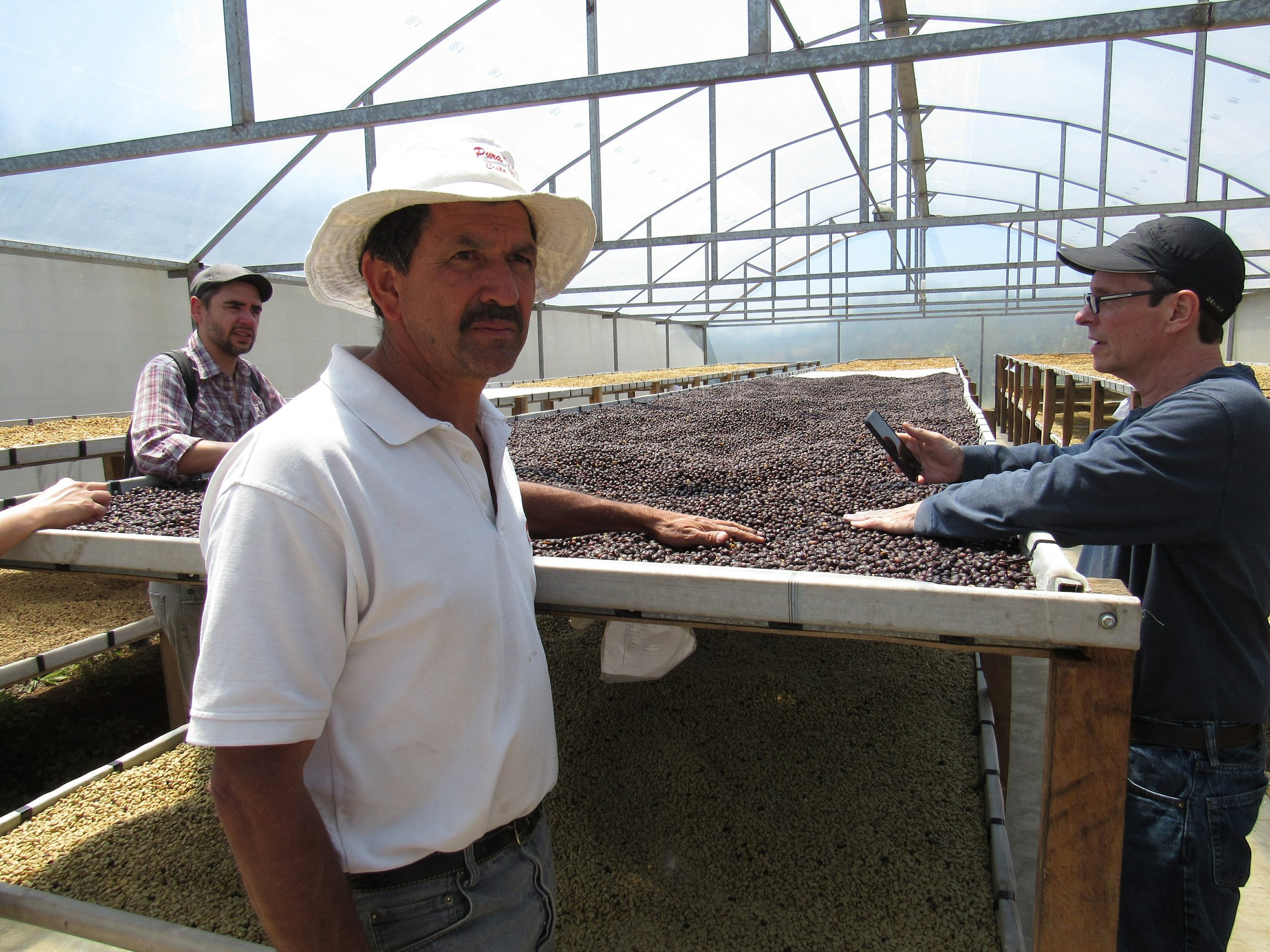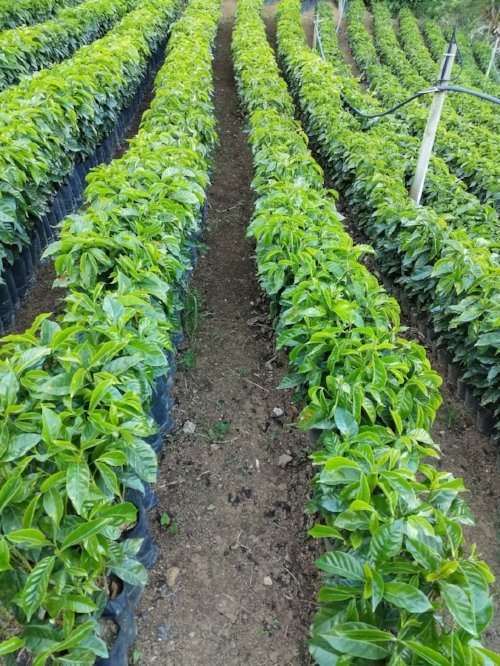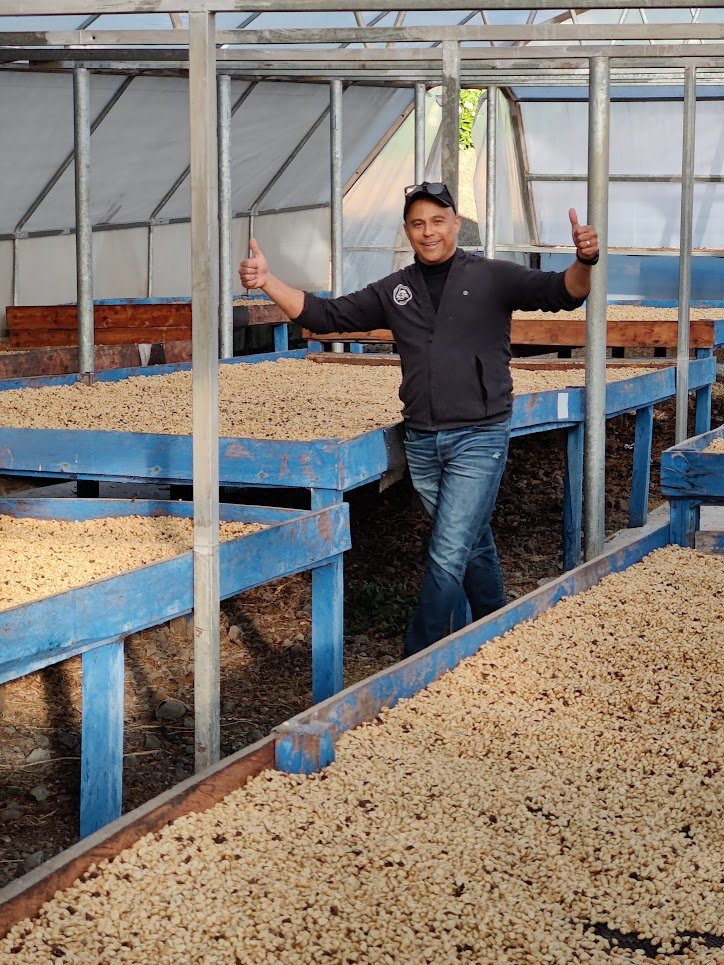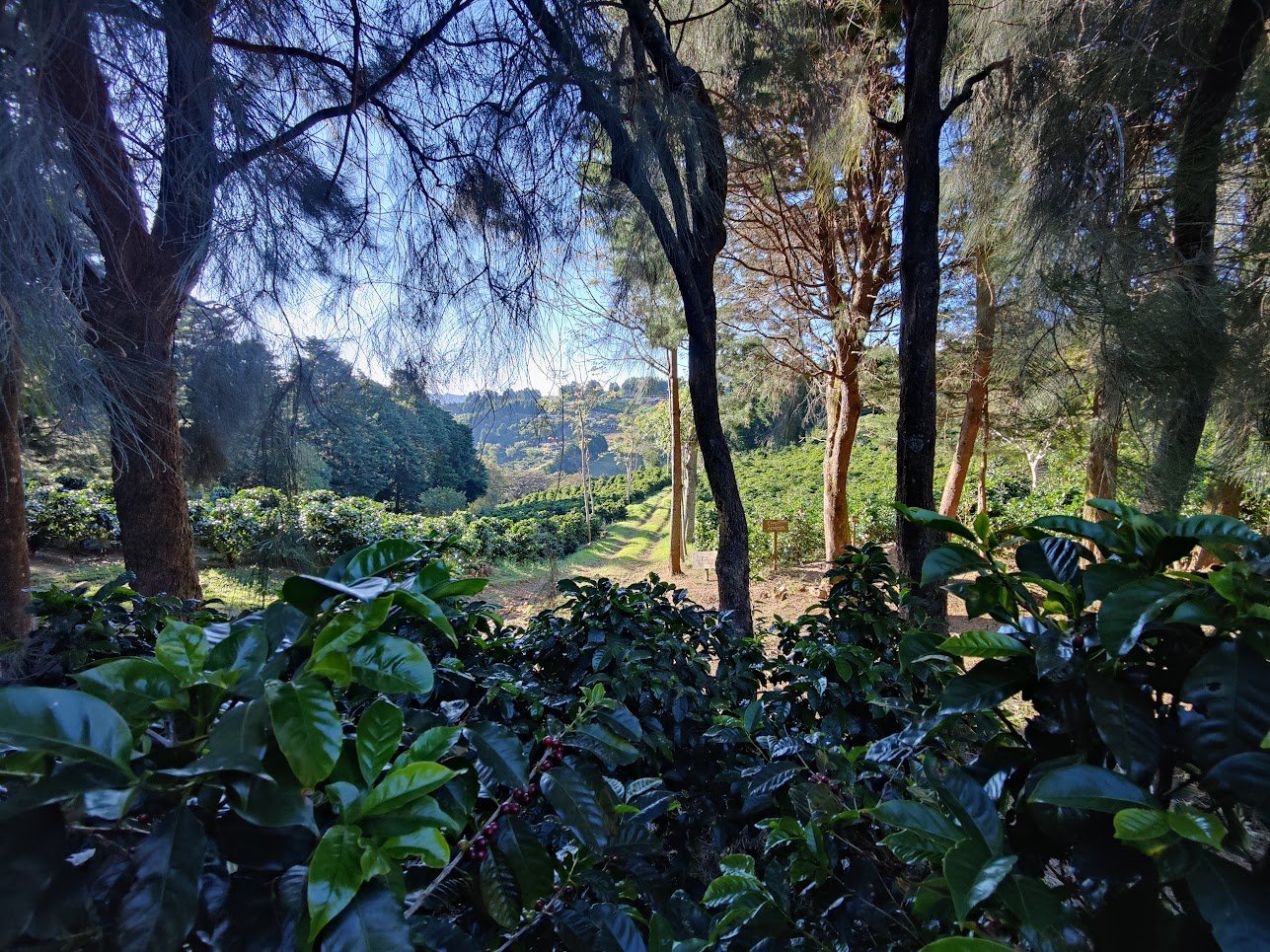
Coffee is People.
Here are some of the incredible people we get to work with.
Luis Alberto and Oscar Monge
Finca El Dragon | Finca Pie San
Tarrazu, Costa Rica
Don Luis Alberto and his brother Oscar are tinkerers. They like to ask, "What if?" a lot. You can see those questions being asked all over their farms and mill. The answer comes in the cup, and always makes me smile. Hop into Luis’ old Toyota Land Cruiser and head out with him to what to me has to be his heart-and-soul crowning jewel of a farm, Pie San, and you'll see the questions strewn down the steep canyon-like slopes of the mountain upon which this experimental farm rests precariously, like an emerald blanket of lush coffee trees, the roots of which are surely the only thing preventing the whole enterprise from sliding into the valley below. Walk the gravel road that crosses the top of the farm and see sign after sign delineating sections on the farm of the world's most sought after boutique coffee varieties, all perfectly at home in their adopted environment of cool, alpine Tarrazu, all patiently converting mountain sunlight into nutrients that will get converted to sugars inside the dense, sometimes floral and always sweet seeds of the trees on which they grow. It's a murderer's row of the luminaries of the coffee world all standing next to each other, swaying in the breeze, tempting me to creep ever closer to the edge of the road and closer to a blissful tumble down as I open my wallet to try to buy them all. I could stand there all day watching clouds pile up against and spilling over the mountains across the valley while stealing glimpses of the deep blue Pacific 30 kilometers distant. But we've got more stuff to see and do; so it's back into the Land Cruiser and slowly down the 4x4 only road to the front gate of Pie San and eventually out onto the main mountain road that takes us past the town of San Marcos and over to La Lia Mill.
The mill, named for Luis' and Oscar's sweet, always smiling mother Lia, presents more "what ifs" in the nursery tucked behind the dry mill building that tenderly shelters yet more rare, wonderful seedlings of experimental coffee varieties, all awaiting their moment of glory to be planted in one of Luis' several award-winning farms. After a few moments pondering together what the future holds as we look across this green carpet of morning cups yet to be, we march determinedly toward the drying patios where some workers are diligently washing down one section of patio with a water hose, preparing it for a special deposit of, you guessed it, experimentally processed beans from a small lot on Finca El Dragon, the other of Luis and Oscar’s farms from which we have purchased coffee for many years running now. "Experimental processing" for Luis and Oscar means working their depulping equipment just so to remove just so much of the mucilage fruit layer from the beans in this microlot until they look and smell, well, just so. From there they'll be carefully laid out on the aforementioned patio space and methodically turned in the Costa Rica sun with what looks like a wooden rake minus the teeth, every hour on the hour for the next week until the beans are at the precise moisture level they deem best for this experiment which, like numberless others, seems to be running concurrently, fluidly, in his mind like a mountain river flowing toward the sea.
A short time hence, the product of all their experimentation will indeed reach the sea and onto our shores in the form of clean, sweet coffees that are crisp and acidic, like a classic Costa Rica coffee, but with a certain added layer of sophistication and nuance, the result of the endless hours of thinking and tinkering Luis and Oscar do all harvest long. Generally, Luis and Oscar prepare El Dragon for us as a Yellow Honey process, meaning they’ve left perhaps 40-50% of the fruit mucilage on the beans to dry, which imparts a creamy base of nougat-like sweetness atop the familiar green apple and Riesling acidity this coffee is known and loved for. In the past we’ve asked them to process El Dragon in a wild variety of ways: White Honey (~25% mucilage); Yellow Honey; Red Honey ( ~75%) and Black Honey (~100%). But we always come back to the sweet, creamy but refined acidity of Yellow Honey.
The last few years we've purchased the SL-28 (a Kenya coffee variety) microlot from Pie San, which always manages to stun and delight us. This year we switched things up a bit and grabbed a Gesha variety that is a Black Honey, anaerobically processed. The results are jammy and mind-blowing. We’re so grateful to have another beautiful lot from Pie San, alongside another year's worth of El Dragon, and celebrate the culmination of all of Luis and Oscar’s "What ifs" as they materialize into liquid beauty in your cups.
Ejo Heza
Kopakama Mill , Rutsiro District,
Rwanda
Out of tragedy, hope.
No one goes looking for tragedy as the start of a story. And yet in the tiny country of Rwanda, the story of tragedy still lingers large. After a tumultuous few months in which the country was ripped in half in the mid 1990’s, the country felt as though it had burned to the ground. Friends, neighbors, colleagues — all turned to enemies in the blink of an eye. And yet a generation later, somehow, against all odds, this beautiful gem of a country has reunited and grown like a phoenix out of the ashes to become one of Africa’s fastest growing economies and sought-after destinations for coffee.
As international rebuilding aid poured into the country following Rwanda’s civil war, one of the areas of industry that was left virtually unscathed in terms of infrastructure was coffee. The problem? So many of the men of Rwanda were no longer alive to keep the industry going. As Rwandan women dusted themselves off and began to take stock of what remained, they began to realize that there was a slim but important silver lining to their situation. It had become fashionable at the time for coffee producers to uproot their heirloom Bourbon variety trees in favor of higher yielding, or more disease resistant cultivars coming onto the market. But war has a way of focusing the mind elsewhere; and so in the aftermath of wreckage, Rwandan women not only decided to teach themselves how to grow, care for, harvest and process coffees on their own, but to do so with a country full of classic heirloom variety trees.
We have Ejo Heza (“Bright Tomorrow”) this year, from one of the oldest mills in Rwanda—Kopakama. The coffee is plush with tones of red grape, peach and honey. Delicious as espresso. This is the fifth consecutive year we have partnered to bring these sweet, complex coffees from Rwanda into our world to share it with as many people as possible. This season’s coffees were even better than last season’s, and we have every expectation that this cooperative will continue to soar well into the future. We believe in Rwanda as a consistent source of world-class coffees. We believe in the women of Rwanda and their mission. And most of all, we believe in the coffee.
Many thanks goes to our good friend Ruth Ann Church of Artisan Coffee Imports, without whose guidance we would never have known the amazing story of these coffees and their producers.
Miguel Menendez
Finca Las Delicias | Finca Santa Barbara | Piedra Grande
Apaneca-Ilamatepec, El Salvador
It's all important.
Doing coffee well and right and good means leaving nothing to chance. It means taking care of coffee down to the soil and up to the proper height between the top of the coffee trees and the bottom of the shade canopies. It means purposely incurring the extra expense of keeping a staff of locals in steady employment instead of investing in a quick, one-time capital investment of machinery that will do the same thing as the humans.
These are the things Don Miguel Menendez does as part of his coffee operations in northwest El Salvador. Don Miguel has been at this for decades, and as such he has become a respected member of the business community. He has led the charge to help raise both the quality of the coffees he and others around him produce, as well as to raise the awareness of that quality on an international level by helping secure international AOC-type (appellation d'origine contrôlée) recognitions for coffees from the Apaneca and Ilamatepec departments.
Don Miguel's family owns and operates six coffee farms (four of which are specialty-grade) as well as a wet and dry milling operation called Piedra Grande, so named for the gigantic boulders all around the area, remnants of ancient deposits left from the numerous local volvanoes. He has divided the family's business between his daughter and two sons even though he is very much alive and kicking, doubtless to ensure a seamless transition to the next generation. By all accounts, it's working.
I first visited the Menendez family in early 2011 after a slightly (very) harrowing border crossing between Guatemala and El Salvador (another story). Don Miguel met two of us coffee buyers on the El Salvador side, where we promptly hopped into the cabin of his Dodge Ram truck while his man, shotgun slung over his shoulder (see what I mean?), hopped into the truck bed in back.
Over the next two days we traveled the length and breadth of the Menendez family's impressive coffee operation, listening to Mr Menendez, or his agronomist, or his various farm managers speak articulately and exhaustively about fixing the right inputs in just the right quantities into the soil or onto the coffee tree leaves themselves, as the case may warrant, to keep it healthy, disease free and balanced, and to coax the trees to produce superior taste quality. Or about what they believe is the proper humidity level for coffee trees to be happy and how one can manage the shade canopy to maintain those levels. Or about planting massive windbreak trees to help delicate Bourbon trees maintain their coffee cherries during storms and strong winds. Or about an incredible new find on one of the trees that one of the managers discovered quite by accident--probably a natural mutation--that was producing coffee cherries with the distinct aroma and taste of ripe peaches.
And so on and so forth, fascinatingly.
We listened to the sound of armies of bees in one of the farms that was in full coffee blossom blooms a week after surprise rains. The sound was deafening and beautiful: a healthy macro-organism being tended in concert between bees, trees and man.
We spoke in hushed tones reverently over a (literal) hole in the ground where they had recently dug out a tree that was no longer producing well, victim of some ailment that affects coffee trees, almost in the way one speaks of an older relative who has just passed. It was best, the explanation came, to spread the tree's remains among its peers, a final gift of itself to the ongoing larger good, as organic matter returned to organic matter and produced yet another organic item, a drinkable one that enriched the lives of all around it.
"Enriched" is a good word. Not because we're talking about fabulously wealthy people. But because the Menendez family is rich where it counts: in heart. Coffee buyers like to come down to farms and hand out checklists of things they want to see, boxes to be ticked to assuage the white para-guilt that consumes so many “First World” consumers these days. I personally like to glance into the eyes and watch the body language of the "little people" when the boss man arrives on the scene. Do they bow, eyes low to the ground, in obeisance, or do they smile that grateful smile people get when they're contented in their work? All I saw was the latter: women chatting it up and laughing as we walked through the dry mill where they were sitting sorting out defects on the coffee treadmill; managers who pull up a porch rocking chair and sit with us--not behind us, or standing--as we watch the sun fall asleep behind the trees and the mountains. People. It's all important. The Menendez family gets this in crystal clear ways. And the coffees provide ample testament to that care and expertise.
The farms, the mills, the whole production was top-level. Heart-smiles were emanating from this coffee buyer as small detail after small detail kept coming up roses in my mental inventory of what a well-run coffee operation should be. These guys had it down.
We have been fortunate enough to have over fourteen seasons of great coffees from the Menendez family. We look forward to many more--because of the coffee details, of course. But also all the other tiny details that were obviously paid attention to. Because it's all important.
Bonilla Family
Finca Cedral | Finca Bona Vista
Tarrazu, Costa Rica
I first visited Don Mayo Mill in 2015 on my very first visit to Costa Rica. Our good friends at Exclusive Coffees make it super easy to source exactly the coffee you want. When you arrive at their headquarters just outside of San Jose, they ask you “what you’re looking for:” Location. Variety(ies). Processing. Altitude. And so forth. Then they set about getting cupping table after cupping table of coffees from the region(s) you requested. First is West Valley. 12 coffees with three samples per coffee. 36 coffees. You take notes on which you like and at the end of the session they ask you which ones you liked. “I liked number 5, 9, 11 and 12.” They note it and we move to the next table. Central Valley. 13 coffees… then Tarrazu… then… until you almost can’t see straight from caffeine overload.
The next day or two are travel days. You hop in a van with a couple other coffee buyers from Canada, Europe, maybe Japan, and you visit the farms you indicated you liked from West Valley. The amazing thing about Costa Rica is that when you step out of the van at the very first mill and you meet the owner, he tells you, “Tenemos Gesha, SL-28, Bourbon, Pacamara y Typica. Tenemos lavado, miel blanco, miel amarillo, miel rojo, miel negro y natural.” It’s a candy store and you’re the kid. Any coffee variety, any processing method, any quantity. Here it is. You’re ready to buy out the whole mill. You steady yourself and keep your pocketbook in your pocket for now because it’s just the first mill of the day on the first day of visits. So you get back in the van and visit the next mill just a few miles down the road and get out, meet the producer and she tells you pretty much the exact same thing as the first producer. And the next visit, and the next, and so forth. “What’s going on here? How am I ever going to decide which coffee(s) to buy?” you ask yourself.
And into that milieu you have to make a final decision about what to purchase. You must go back and rely not just on your sense of sight at each mill/farm, but also on your notes. Take notes. Lots of them. Because they will serve you well when you’ve just spent three days traveling across almost every inch of coffee producing country in Costa Rica and you can’t remember who from what. That first year one of the gems that kept pushing up through the rough was my visit to Don Mayo Mill. You see a lot of operations in a short space of time and the better operations stay with you. That was Don Mayo Mill. You knew they knew. Don Hector has been at the helm forever. And over the last few years his son Pablo has been driving quality and driving relationships.
We have recently been fortunate enough to bring in a mind-blowingly beautiful coffee that is one of Don Pablo’s gems: Reserva Cedral. This lot is comprised of 100% Gesha variety, perhaps the most famous specialty variety in the world. There is a lot of “Gesha” out there being grown by lots of “world-class producers.” But this is Gesha. And this is Pablo Bonilla and Don Mayo Mill. Red Honey processing makes this coffee explode juicily with notes of red wine, black fig and a delicate honeysuckle underneath it all. Tell your palate you know what you’re doing and grab a bag of this amazing coffee while our supply lasts.
Out of the several farms Don Mayo Mill produces, the other consistently best coffees (in my opinion) come from Finca Bona Vista. It is consistently a stand out coffee at a stand out mill. We bought some that first year of 2015-16 and in the intervening years our purchases from Costa Rica ranged far and wide until recently again I knew I had to bring this coffee back. So we did. White Honey processing keeps just enough sweet crispness without dulling the bright signal. Cane sugar. White grape, Pear. Crisp and refined and exactly what I think of when I think of the proto-Costa. Finca Bona Vista is so well-built and consistently delicious cup after cup. It’s definitely an all-day drinker.
Note: The traditional name of Bona Vista used to be “Bella Vista.” However, recently, a certain large, green multinational coffee company you surely know, who also carries a coffee with that name has sent a “Cease and Desist” note to Don Hector and Don Pablo, forcing them to sligtly alter the name to “Bona Vista.” Same great coffee. Almost the same name.
Edwin Martinez
Finca Vista Hermosa
Huehuetenango, Guatemala
Edwin Martinez is a thoughtful guy. Often on the phone with him we’ll be talking about whatever topic, and all of a sudden the phone goes silent. I used to think the connection had gotten lost and I would start in on the usual, “Hello? Can you hear me? Edwin?” stuff, when all of a sudden he would speak again, usually with something carefully thought out and wise. I realized before long that he’s a man who chooses his words intentionally.
It would be fair to say the same about the farm he is now the third generation owner of. Finca Vista Hermosa started as a single lot of coffee farmland gifted to Edwin’s grandfather, a local preacher/evangelist in 1957 as a “gift” to him from a parishioner. Over the years as operational ownership passed through to Edwin Sr (Edwin’s father) and then to Edwin himself (sometimes referred to as “Eddie” to denote him from his father), they acquired more adjacent parcels and continued the long process of making agricultural sense of it all. Leaving this area of virgin forest with a natural spring intact. Replanting that microlot with one variety instead of the mish-mash of “seeds” one used to buy at the market or in Guatemala City. Planting multiple shade layers of trees to prevent erosion and provide better biodiversity for local wildlife. Building a small school and clinic for the remote valley’s many children. And so forth. Thoughtful growth.
Today Finca Vista Hermosa is ten or eleven distinct microlots, each with its own unique geographical and taste characteristics. We have bought most of them over the years, based on what Edwin thought tasted best, or, in the lean years when Coffee Leaf Rust was devastating most of Central America’s coffee farms, whatever he had available. But every year the coffees from Finca Vista Hermosa are always world-class. Sweet with a meaty minerality and a lovely hint of salted caramel, reminiscent of the rocky lime soil substrate all over this part of Guatemala. And always with that classic salted caramel tone as it cools.
We always feel blessed to buy from Edwin because—fun fact—Edwin sold me my first two sacks of coffee (about 300 lb) ever, way back in…2006? I remember at the time wondering how in the world I was ever going to sell that much coffee. But we did, and over the years his coffees have consistently been best-sellers from us. Come see why.
Francisco Mena
Finca Monte Lourdes
West Valley, Costa Rica
Francisco Mena is a busy man. He’s been busy for over a decade, building and growing what is arguably the world’s premiere coffee discovery gateway company, Exclusive Coffees. Costa Rica has to be in anyone’s conversation about coffee producing countries with the most sophisticated, advanced and quality-forward producers. The country is crawling with them. And if you want to be introduced to the best of the best in Costa Rica, you need to know Don Francisco and Exclusive. Your first visit to Exclusive is to cup tons of coffees in a quality-discovery exercise. Each table represents coffees from a different growing region in Costa Rica. You cup the coffees; you score the coffees; you communicate your favorite coffees from that table; it gets written down; and then you do another table. And another. And another; until your dance card is filled. The next morning you’re up with the sun and bolting out of the capital to all the farms in that particular region you liked on yesterday’s cupping table. Four or five farm or mill visits to meet the respective producers, see their operation and get a feel for things. Then off to the next farm/mill. All day long. Sometimes two growing regions can be visited in one long day. After a couple days you have a good idea of what and who you might want to align yourself with. So you tell Francisco. Francisco fixes things. He fixes everything. That is what he and Exclusive do. That’s all they do. Until…it’s not all they do. A few years into Exclusive and Don Francisco bought a farm and a mill and began producing his own coffees to add to the constellation of Exclusive Stars. Sumava de Lourdes Mill produces coffees from two of Francisco’s farms with precision and careful attention to detail. All the ingredients are there: altitude; climate; varieties; facilities; technical know-how. It was almost a foregone conclusion that anything Francisco produced would be amazing.
And it is amazing. Although we have known Francisco for many years, the 2021 harvest was the first season we purchased any coffees from him. And oh, what a stunner it was. Monte Lourdes was the first coffee we purchased where the cherry is processed using a new system called, “Cherry Reposado.” The idea is that when cherry is harvested from a tree and the enzymatic process between tree and cherry stops, the sugars in a cherry can change dramatically, altering flavor significantly. By “resting” the just-harvested cherry in the cool shade for up to 72 hours, a producer can stabilize that rapid enzymatic degradation and keep sugars more intact heading into the rest of the processing. The result is an unbelievably fresh, sweet fruit expression without having to resort to picking overripe cherry to push fruit forward in the taste mix.
We generally have an extremely limited supply of Monte Lourdes coffee each year. Coffees this rare, this beautiful are separated by Exclusive into a special program called the “50 lbs Elite Coffee Project: Reserva del Productor.” With so little to go around, you will not want to miss this sweetly satisfying coffee anytime you see it available on our site. It’s often a Villa Sarchi variety and the Cherry Reposado process pushes fresh bing cherry; mango and red apple into your mouth with a pleasant pectin acidity. Having coffee like this is almost like watching your first 4k movie after adjusting bunny ears your whole life. The clarity pops right out at you.
We also are incredibly excited to have one of Francisco’s pride and joy microlots for 2022-23: La Ladera “Jennifer,” named for his wife. Anytime a man names something after his wife, you can be sure that thing will be his all-consuming passion. Ladera “Jennifer” is no exception. It continues Francisco’s groundbreaking “Cherry Reposado” processing techniques and adds a delightful surprise twist—it is a lot comprised of the exotic and rare (for Costa Rica) SL-28 variety, the variety that made Kenya coffee famous the world over. By taking this Kenyan cultivar and caring for it in the volcanic soils of Costa Rica, Francisco has gifted the world a poem. The coffee is White Honey processed, and it the most stunning representation of what raw coffee cherry tastes like on the farm itself. The sweet fruit mucilage of the cherry is plush with notes of ripe cantaloupe; lightly acidic like blackberries and full of malic sweetness like red apples. You simply must try this coffee.
Tonio Barrantes
Finca La Planada | Finca Lorena | Finca El Torre
Tarrazu, Costa Rica
Tonio Barrantes might be the coolest coffee farmer in Costa Rica. Maybe on the planet. He’s just one of those guys who you know has forgotten more about coffee than most humans will ever know. He cuts a quiet but impressive figure from the moment you meet him. It’s that kind of quiet confidence, coupled with simply amazing coffees that has kept made us keep buying coffees from him.
I first met Tonio in 2015 and needed to buy coffee from him. Needed. Alas one has to make sacrifices when one shops for coffees in Costa Rica and I had to keep his famed Herbazu Mill on my “Wish List” of coffees to circle back around to in coming years. Of course I would. His mill was impossibly spotless and clean…in the middle of harvest. Normally one visits a mill and gets the whiff of rotting fruit and hears the buzzing of flies attending to said rotting fruit. Not nauseatingly, but it’s there. It’s almost impossible to NOT have that scene when trucks full of coffee are being pulped every day at the height of harvest. You keep things in a state of managed chaos during harvest. But not at Herbazu. We arrived in the morning last year on a return visit and my first question was, “Are you already finished with harvest here?” It was that clean. That orderly. Almost like a coffee museum. But no, they weren’t finished. “The trucks will be here in a minute,” he coolly said. In fact that week was their busiest week, Tonio told me. That’s when I was reminded why I needed to buy coffee here. Tonio and his family know what they’re doing. They invest in amazing coffees; grow them carefully using thoughtful environmental conditions; harvest them at their peak ripeness; and process them meticulously. His “farms” are often small plots of boutique varieties that make even the most experienced coffee buyer drool.
About the coffees I will say this. Each year, Tonio’s coffees taste to me the closest a coffee can taste to “perfection.” Having visited countless farms and mills in my two decades in specialty coffee, I’ve tasted a lot of coffees, from pulling ripe cherries off the tree and plucking them into my mouth, to brewing coffees in the shops. So when I say “perfection” I mean they taste the closest to what I know coffee can taste when it’s harvested perfectly ripe; roasted well; and brewed to exacting standards.
Earlier this year we were back to visit and were bummed to learn upon our arrival that Don Tonio wasn’t around. His nephew confirmed that Don Tonio knew we would be there; but he had been called away on some errand or another. Oh well. We toured the farm and the drying tables again and said our goodbyes to Tonio’s team.
Later that afternoon, as we were driving through town on our way back to San Jose for the night, our driver suddenly stopped in the middle of traffic and said, “There’s Tonio!” He was standing across the street, next to his truck, visiting with a friend and waiting to unlock the church doors for the evening service. We jumped out and spent a few great moments catching up and telling him what fanboys we are of every coffee he’s ever done in the history of doing coffee. Fanboy-ing aside, it was a special moment of human connection I always look forward to every time I travel for coffee.
Our Herbazu coffees are always small in quantity but large on experience. They are diamonds and caviar. You don’t need a lot to enjoy them. And enjoy them you will, I guarantee.


